It happens that there is not enough heat. The conversation is not about warmth. It's about heating. In half of the territory of Russia, subzero temperatures can be kept for 5 or more months, therefore it is so important to make sure that the house or dacha is warm. There are a lot of options to warm your home, from conventional stove heating to various types of heaters. There are so many technologies and principles of operation of thermal equipment at the moment that the question involuntarily arises as to what to choose.
Content
What characteristics should heating devices have?
- Fire safety. The equipment must not use an open flame during operation or have hot parts in its structure that could cause a fire. Popular in the past, electric heaters with an open coil, if safety requirements were not observed, often became the cause of fires.
- Environmental Safety. During the operation of heaters, harmful substances should not be emitted, oxygen should not be burned or the humidity in the room should not significantly decrease.
- Profitability. The less the consumer pays for the energy spent on heating, the better. When using powerful electrical appliances for heating, due to imperfect technology consuming an increased amount of electricity, the electricity bill can double, especially during the colder months.
Electric convectors answer all three points. Let's dwell on what they are, what they are and how they work.
What is a convector?
The name of the device contains a physical phenomenon that it uses during operation.
Convection is a type of heat exchange in which internal energy is spread in jets or streams. Using the example of a heating device of the same name, it looks like this. Structurally, the convector is a heating element and a radiator screen with openings at the bottom and top. Cold air, in contact with the heating element, heats up, changes its density, and under the action of the Archimedean force rises upward in a stream.
The process will be continuous until the room is heated to the required temperature.
What convectors are there?
- By the type of energy used - electrical, gas and water. In the review, we will focus on electric, as the most economical and widespread.
The efficiency of electric convectors is unusually high for heating devices and reaches 90%. Such indicators were achieved due to the simplicity of the design.
In addition, they do not have a negative effect on the microclimate in the room, the heating element in the equipment heats up to 60 C °, at this temperature it does not evaporate moisture from the air and does not burn oxygen. - By installation method.
Mobile or outdoor. Placed on the floor, easily moved if necessary. Some models are equipped with casters for easy movement.
Wall mounted. Are fixed permanently.It is recommended by the manufacturer to install the devices in such a way that the lower edge is at a height of 10-20 cm from the floor. - By the way of ventilation.
No fan. Warm air spreads naturally. At the same time, the air flow moves more slowly, but the heater is absolutely silent.
With a fan. The use of a fan in the structure accelerates the flow of heated air and warms up the room.
Which convector to choose?
The power of the convector, like that of any climatic equipment, is calculated based on the size of the room. The indicator of area to power is taken in the ratio of 100 W per square meter, for a room with an area of 15 square meters. m. you will need equipment with a capacity of 1500 watts. However, experts recommend laying some margin for heat loss due to drafts or low temperatures. Heater sellers advise to choose equipment 10% more powerful than the area of your house and apartment and install thermostats or temperature controllers if they are not provided in the equipment design by the manufacturer. This will make it possible to control the microclimate at home on your own.
Can an electric convector fully satisfy the heat demand of a house?
With proper thermal insulation of the walls and their sufficient thickness, electric heaters, in particular, wall convectors, can be the only sources of heat in the house.
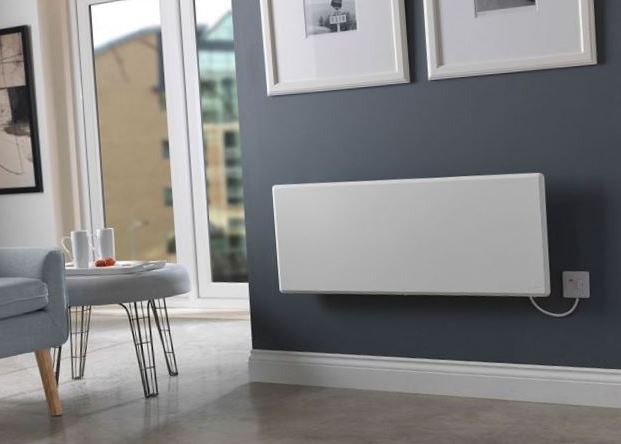
What additional accessories should I choose for the wall convector?
For models without power control, it is recommended to purchase a thermostat that allows you to change the temperature mode.
Centralized control systems such as "smart House», Where all devices can be controlled from a smartphone or laptop. Leading equipment manufacturers offer the integration of their devices into a common control system. Control modules are not included as standard. The connection is best done after consulting with specialists, and, possibly, with their participation.
The editors of the site bestx.htgetrid.com/en/ have prepared for you a rating of the best electric wall-mounted convectors for 2020.
Best Electric Wall Mounted Convectors for 2020
The review includes:
| Thermor Evidence 2 Elec 1500 | 4510 |
| Nobo NTL4S 15 | 10400 |
| Nobo NFK 2S 12 | 10600 |
| Nobo NTL4S 05 | 8910 |
| Roda Standart 1.0 | 2090 |
| Electrolux ECH / AS-2000 MR | 4340 |
| Nobo NFK 2S 10 | 9680 |
Thermor Evidence 2 Elec 1500
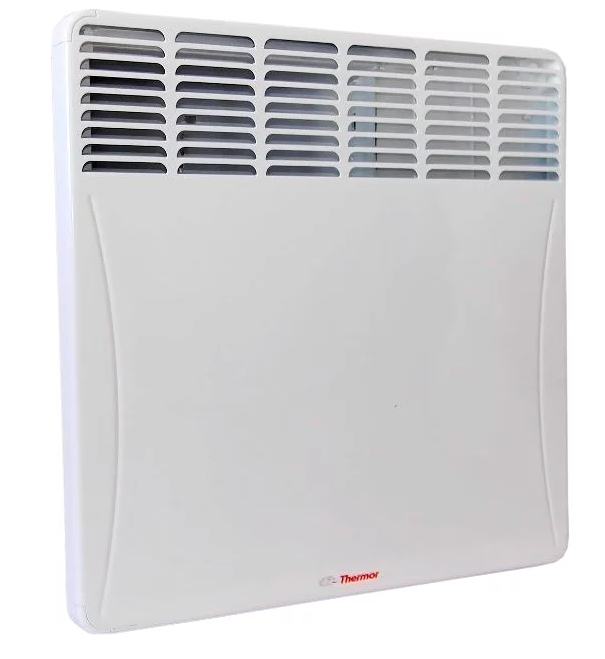
On the seventh place of the review is the device of the French manufacturer. Thermor specializes in the production of electrical heating appliances. The history of the company goes back 80 years. The first model of an electric convector was released by the company in 1987. Since then, specialists have been improving technologies, paying special attention to energy saving and environmental safety of their products.
In 2001, an anti-dust protection system was developed and successfully introduced into the devices.
Anti-dust protection - a set of technologies that prevent dust accumulation. This is achieved through the use of smooth antistatic surfaces in the production, and the arrangement of the air outlet holes in such a way that the flow is not directed vertically, but deviates from the wall, without raising dust particles into the air.
Convector power 1500 W. It is enough to heat a 15 sq.m. room.
The built-in thermostat controls the degree of heating and has 4 operating modes.
The maximum temperature of the heating element does not exceed 60 ° C, if this indicator is exceeded, the protection will work and the equipment will turn off.
The device uses Thermor's own development - HD technology, the result of the joint work of technologists and designers. Due to the changed geometric shape of the surface of the convector's front panel, the device is characterized by efficient heat transfer. The front panel of the convector heats up quickly and evenly, this ensures an even air flow without drying it out and maintaining a comfortable microclimate in the room.
To control the temperature in the electric convector, four modes are provided:
- Economical;
- Comfort;
- Anti-freezing, will allow you to withstand the set temperature in a country house in your absence, without leading to excessive consumption of electricity;
- Programming. In this mode, you can configure the simultaneous operation of several convectors connected to each other. Also, the device can be integrated into the "smart home" system to control its work remotely, or on a schedule.
Advantages:
- High quality workmanship;
- Flexible choice of operating modes;
- Temperature sensor;
- Overheat protection;
- Roll-over protection;
- Dust protection.
Disadvantages:
- Not identified.
Nobo NTL4S 15
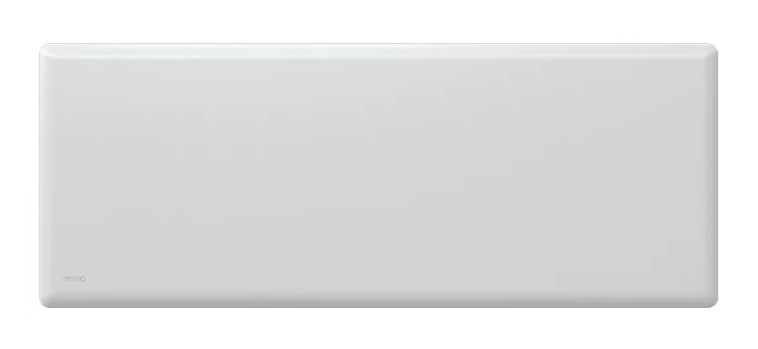
The unit of the Norwegian manufacturer is in sixth place. The company produces heating equipment, accessories and control systems for it. Nobo products have received numerous international awards for quality and reliability. The manufacturer carries out strict quality control of components and finished products and therefore gives the equipment a rare 10-year warranty.
Convector Nobo NTL4S 15 is designed for wall mounting. As an option, there are legs that turn the device into a floor-standing one. They are purchased additionally.
The power of the device is 1500 W, the instructions indicate that it is enough to heat a room of 19 sq.m.
The convector has one operating mode. Teng is used as a heating element, the maximum temperature of which reaches 100 ° C. The front panel temperature does not exceed 30 ° C, which excludes the risk of burns.
Advantages:
- 10 years warranty;
- High quality workmanship;
- Overheat protection.
Disadvantages:
- One operating mode, thermostat sold separately.
Nobo NFK 2S 12

The fifth line of the rating is occupied by another representative of the Scandinavian brand.
The NFK series is distinguished by its laconic design and compact dimensions. With a similar size, the model produces 1250 W power, due to the ergonomic design, the turbulence of the outgoing air flow is reduced, this increases the efficiency of the convector, while simultaneously reducing energy costs. The device heats up an area of 19 sq.m.
To adjust the operation, the NFK 2S 12 is equipped with an electronic thermostat that allows you to customize the operating modes for yourself.
In addition, the company offers convector control systems. After installing and configuring the system, the user can combine several devices into a group, receive information about the status of the equipment on a tablet or smartphone, turn the device on or off remotely, and create a work schedule.
The heater has an IP24 protection class and can be installed in humid rooms.
Advantages:
- Compact dimensions;
- Absolute noiselessness;
- Overheat protection;
- Temperature regulation.
Disadvantages:
- Not identified.
Nobo NTL4S 05
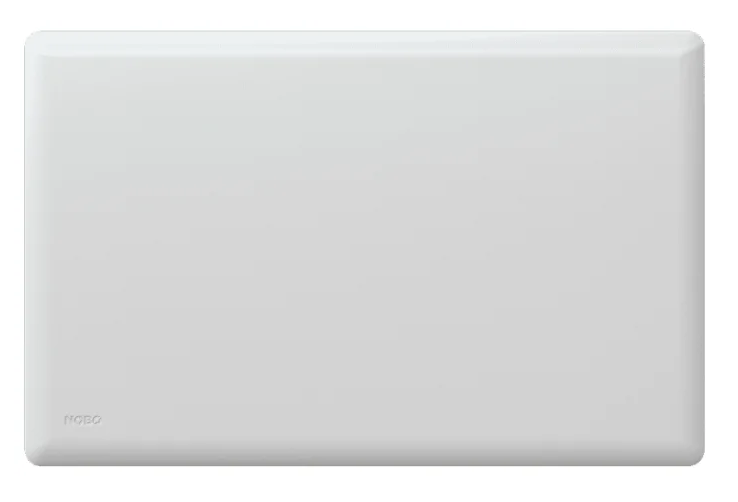
The model is the junior version of NTL4S 15. The convector's power is 500 W, which is enough for a room of 7 sq.m.
The built-in thermostat with a slider makes it possible to set a comfortable temperature regime, and the moisture protection allows the equipment to be used in rooms with high humidity.
The highlight of the model is the interchangeable tempered glass panels, which give them an original and modern look. The panels are available in three color options - anthracite, blue and white. The surface texture is smooth, the edges are rounded, the edges are polished. The panels are safe to use.
Advantages:
- 10 years warranty;
- High quality workmanship;
- Overheat protection;
- Replaceable glass panels.
Disadvantages:
- Not identified.
Roda Standart 1.0
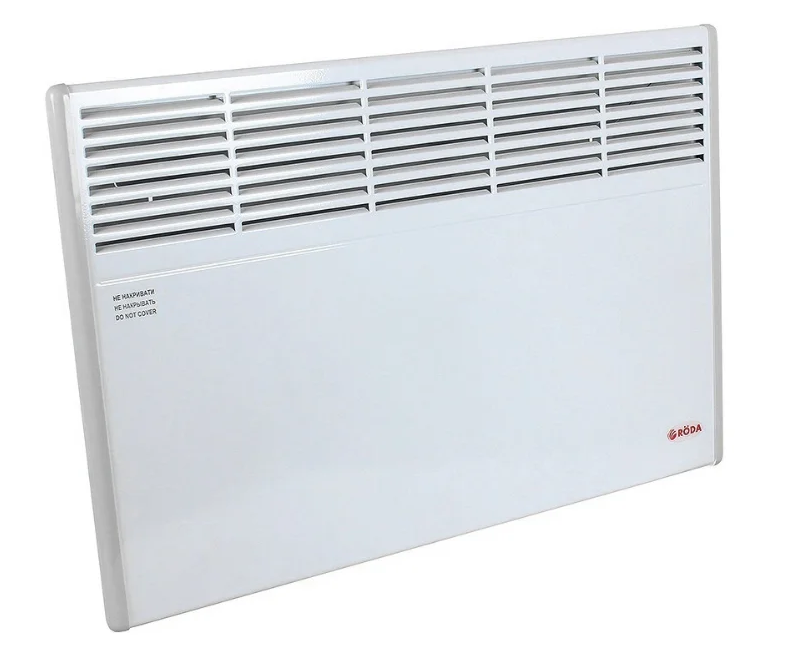
In the next place is the convector of the RODA company, made in Germany. A design feature is a tape heater. Due to the large area of the aluminum plate of the heating element, the device quickly reaches the operating temperature, while maintaining a favorable microclimate in the room.
The power of the device is 1000 W. Installation options: wall or floor.
The convector meets safety requirements, the front panel does not heat up above 60 ° C, a protective shutdown is provided in case of overheating.Protection class IP20, can be installed in damp rooms.
Advantages:
- Profitability;
- Quick exit to working temperature.
Disadvantages:
- Not identified.
Electrolux ECH / AS-2000 MR
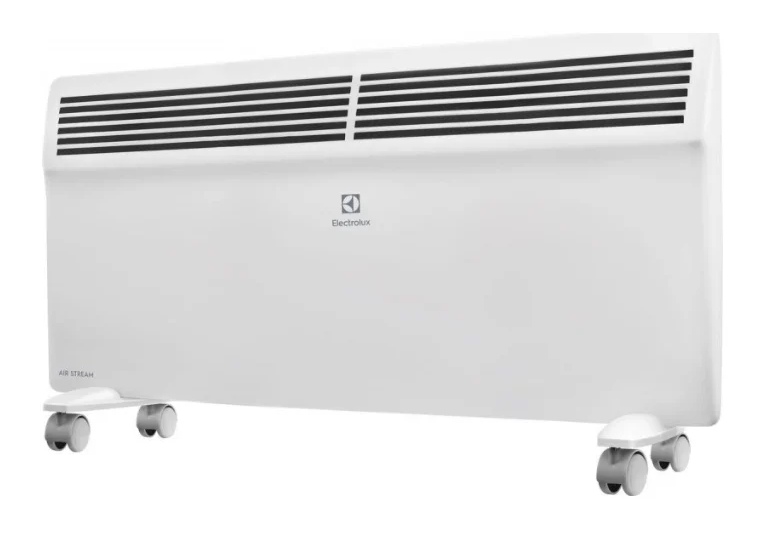
The Swedish brand is well known to the Russian consumer, first of all, for kitchen appliances and washing machines. Over the past three years, the company has been actively entering the market of climate technology and convector-type heaters.
Electrolux ECH / AS-2000 MR - a convector with options for wall installation and floor use. The kit includes wall mounting brackets and a set of stands with wheels. The buyer is free to choose which use case is more convenient for him.
The power of the unit is 2000 W, two modes of operation are provided, for 50 and 100 percent power. The safe use of the convector is ensured by an overheating sensor and a rollover protection sensor.
Advantages:
- High build quality;
- Overheat protection;
- Two mounting options;
- Brackets and feet with wheels included.
Disadvantages:
- Impossibility of smooth regulation of operating modes.
Nobo NFK 2S 10

Topping the rating is a convector from Norwegian masters of climatic technology.
The review already contains a model similar in parameters - Nobo NFK 2S 12
The NFK 2S 10 has the same design as its more powerful sibling.
The power of the device is 1000 W, the equipment is designed for installation in a room with dimensions of 10-11 sq.m.
An X-shaped plate is used as a heating element. This form increases the area of the working surface of the heating element, which, in turn, reduces the energy consumption for heating and reaching the operating temperature. In addition, this shape ensures complete quiet operation.
A thermostat is installed on the back of the heater for power regulation. The manufacturer installs an overheating protection device in its convectors, which guarantees the safety of the equipment.
Advantages:
- Silent work;
- Overheat protection;
- Temperature regulation.
Disadvantages:
- Not identified.
Safety measures for the installation and operation of electric convectors
- Do not block the air outlet openings. Despite the overheating protection installed in most models, this negatively affects the life of the equipment and can cause a fire.
- Connect the convectors only with the standard power wires supplied in the kit. If the connection is impossible for some reason (for example, there is not enough wire length), use wires of the same brand and section as included in the delivery set. The use of wires of a smaller cross-section is fraught with their heating and short circuit.
- Pay attention to the protection class of heating devices. Do not install models in wet locations that have not been prepared for use in wet environments.
- Fasten the equipment securely, use the supplied hardware. Do not use wall convectors as floor convectors.
- At least once every six months, inspect the equipment, the wiring is in good order and clean it of accumulated dust. For any manipulation, the heater must be disconnected from the mains.
- Do not paint the bezels of heating appliances or attach stickers or magnets.
If you have experience in operating wall-mounted electric convectors, or have any questions or suggestions, share them in the comments.












